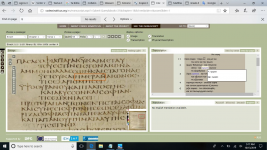Steven Avery
Administrator
Textus Receptus Assembly (2019)
https://www.facebook.com/groups/467217787457422/permalink/475654453280422/
Textus Receptus Assembly (2021)
https://www.facebook.com/groups/467217787457422/permalink/859008994944964/
Timothy Berg - Nick Sayers and Elijah Hixson (2020)
https://business.facebook.com/timot...06596529511&reply_comment_id=2668549439848560
Textus Receptus Assembly (2023)
https://www.facebook.com/groups/467217787457422/posts/1366323874213471/
Zosimas Navigation Page and Facebook Discussions
IOSCS - International Organization for Septuagint and Cognate Studies (2018)
https://www.facebook.com/groups/1569061813331911/permalink/2176192915952128/
NT Textual Criticism (2013)
https://www.facebook.com/groups/NTT...=574703872616617&comment_tracking={"tn":"R9"}
Pure Bible (2019)
https://www.facebook.com/groups/purebible/permalink/2470496753042199/
Ammonian and Eusebian sections
https://www.facebook.com/groups/purebible/posts/1960160574075822/
Sinaiticus (2018)
https://www.facebook.com/groups/sinaiticus/permalink/947799285396877/
Zosima Bible
https://www.facebook.com/groups/ZosimaBible/
Eureka! Manuscripts on the Web
https://www.facebook.com/groups/digital.eureka/posts/1403120903124068/
Palaeography
https://www.facebook.com/groups/1557478997849423/posts/2124656217798362/
Archaeology and History Story
https://www.facebook.com/groups/1479546478960585/posts/2156499084598651/
Koine Greek Bible Study
https://www.facebook.com/groups/274...cently_seen&multi_permalinks=1256495741178951
Ancient Wonders of Archaeology, Art History & Architecture
https://www.facebook.com/groups/Archaeology.Prehistoric/posts/1172816016200939/
Yes, there are additional groups that have good postings on Facebook, that are Sinaiticus not Zosimas. I plan to list them here.
https://www.facebook.com/groups/467217787457422/permalink/475654453280422/
Textus Receptus Assembly (2021)
https://www.facebook.com/groups/467217787457422/permalink/859008994944964/
Timothy Berg - Nick Sayers and Elijah Hixson (2020)
https://business.facebook.com/timot...06596529511&reply_comment_id=2668549439848560
Textus Receptus Assembly (2023)
https://www.facebook.com/groups/467217787457422/posts/1366323874213471/
Zosimas Navigation Page and Facebook Discussions
IOSCS - International Organization for Septuagint and Cognate Studies (2018)
https://www.facebook.com/groups/1569061813331911/permalink/2176192915952128/
NT Textual Criticism (2013)
https://www.facebook.com/groups/NTT...=574703872616617&comment_tracking={"tn":"R9"}
Pure Bible (2019)
https://www.facebook.com/groups/purebible/permalink/2470496753042199/
Ammonian and Eusebian sections
https://www.facebook.com/groups/purebible/posts/1960160574075822/
Sinaiticus (2018)
https://www.facebook.com/groups/sinaiticus/permalink/947799285396877/
Zosima Bible
https://www.facebook.com/groups/ZosimaBible/
Eureka! Manuscripts on the Web
https://www.facebook.com/groups/digital.eureka/posts/1403120903124068/
Palaeography
https://www.facebook.com/groups/1557478997849423/posts/2124656217798362/
Archaeology and History Story
https://www.facebook.com/groups/1479546478960585/posts/2156499084598651/
Koine Greek Bible Study
https://www.facebook.com/groups/274...cently_seen&multi_permalinks=1256495741178951
Ancient Wonders of Archaeology, Art History & Architecture
https://www.facebook.com/groups/Archaeology.Prehistoric/posts/1172816016200939/
Yes, there are additional groups that have good postings on Facebook, that are Sinaiticus not Zosimas. I plan to list them here.
Last edited:



